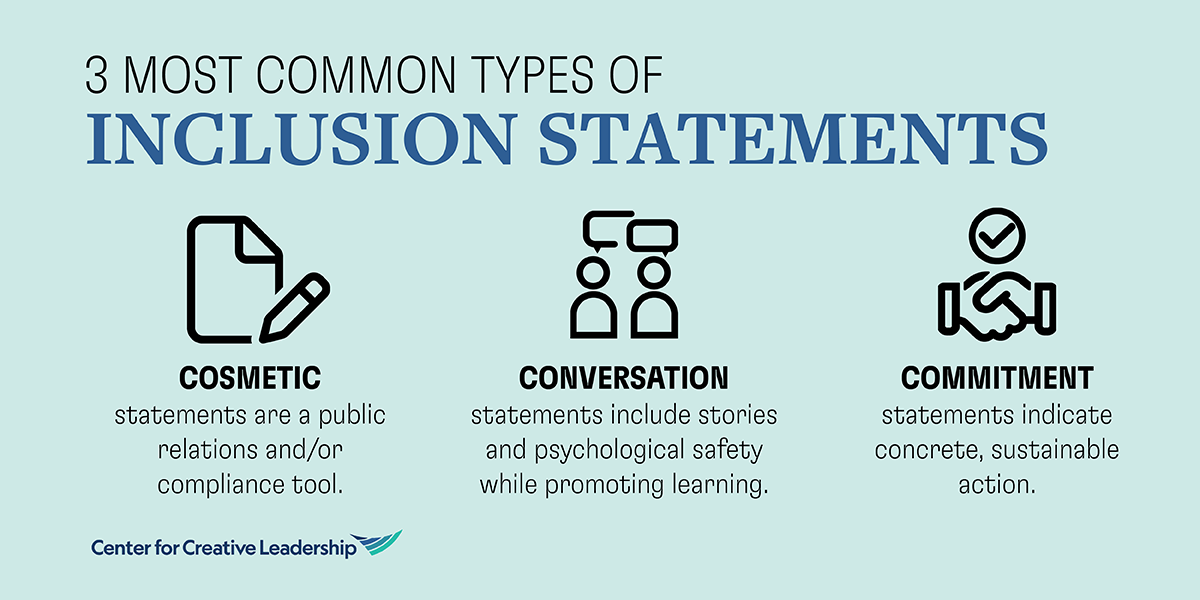Though some organizations had a diversity and inclusion statement in place long before 2020, the collective citizen witnessing of George Floyd’s murder in the U.S. spurred companies across the globe to issue statements that year denouncing racism and pledging to make progress on building more equitable cultures.
Today, the pledges and promises in these statements continue to be urgently important, and there must be organizational accountability for following through with actions that align with their words.
In this article, we’ll discuss what a corporate equity, diversity, inclusion statement is; share findings from our research study on statements issued by Fortune 100 and CEO Action Network companies; and provide advice for organizations on crafting truly meaningful equity, diversity, and inclusion statements and aligning them with measurable action steps to ensure progress.
And to help you get started with actions that lead to sustainable impact, be sure to download our Action Guide for Crafting a Meaningful EDI Corporate Statement & Approach below.
Also, as you may have noticed, at the Center for Creative Leadership, we refer to equity, diversity, and inclusion, or EDI, rather than DEI, with an intentional focus on leading with equity first. Our perspective is that an organization’s DEI efforts will be more effective when framed as EDI efforts, emphasizing the importance of pursuing greater diversity and inclusion only after investing in a culture of equity as the foundation.
Knowing that, let’s take a look at what our research found about organizational “diversity & inclusion statements,” DEI statements or, as we prefer to call it, EDI statements and approaches.
First, What Is a Diversity & Inclusion Statement?
Many of us are familiar with the idea of a mission statement, which describes an organization’s overall purpose and why it exists. Typically, a mission statement acts as a top-level summary about how a business approaches the work it does. Similar to a mission statement, an organization’s EDI statement also summarizes how the business approaches the work it does.
An equity, diversity, and inclusion (EDI) statement outlines an organization’s perspective on social justice issues and the action steps being taken to create a more equitable, diverse, and inclusive culture. Think of your corporate statement on EDI as a roadmap for your organization and, importantly, a way to hold your leadership and organization accountable for change.
Equity, diversity, and inclusion statements are a powerful way to communicate — both to your employees and the public — about your organization’s priorities.
But the intention of developing and issuing such a statement should be to drive real culture change; not to position your brand. EDI statements should never be used as merely marketing tactics.
To signal authenticity, build trust, and create real change, the words in your organization’s equity, diversity, and inclusion statement must be matched with specific, measurable steps your organization is taking to truly move the needle away from cosmetic promises and toward committed actions.
Why Does Your Organization Need an EDI Statement?
An EDI statement gives your organization an approach to tackling equity, diversity, and inclusion issues. It’s a clear and succinct way to articulate your company’s values, expectations, and goals when it comes to EDI.
At this point, little needs to be said about the business benefits that arise from cultivating a diverse workforce. Statistics clearly show that diverse and inclusive businesses are more innovative, profitable, and attractive to talent. Employees deserve to work for companies who embrace these values, and they also expect it.
According to an Axios survey, roughly 80% of employees expect their company to act on matters such as racism and social justice. And the 2022 Edelman Trust Barometer shows that 60% of respondents expect CEOs to speak publicly about controversial social and political issues they care about.
Increasingly, we are in an age of employee activism; workers are seeking purpose-driven leadership. Employees want their leaders and organizations to take a stance on important topics — and silence is, in itself, a statement.
Corporate equity, diversity, and inclusion statements are a great way to announce and clarify your values, initiate change in your organization, and ensure that conversations about this crucial work are ongoing.
What Our Research Suggests About Corporate Statements on Diversity & Inclusion
At CCL, we wanted to better understand effective EDI communications and uncover relationships between EDI statement content, leader motives, and proposed organizational culture change. To do this we conducted a research study built on a web scraping application to analyze corporate statements from Fortune 100 and CEO Action Network companies in response to systemic racism.
Through analyzing 200+ corporate EDI statements, 3 consistent content themes emerged:
- Oppression is everywhere, all the time: In response to the public witnessing of George Floyd’s murder, many leaders issued statements that acknowledged oppression and the systemic mistreatment of certain groups by other groups. The statements widely recognize that oppression exists within organizations and organizational networks.
- Leaders are invitational: This observed theme casts senior leadership as open-minded, empathetic, and interested in finding common ground to promote understanding. Invitational leaders acknowledge and address systemic oppression, everyday racism, inaction, and silence. They know EDI work moves beyond cosmetics when employees feel safe, valued, and empowered.
- Messages and metrics should match: Here we see listings of desired general outcomes for organizational action that align with the acknowledged issues and goals. Desired outcomes are presented as short- to medium-term positive improvements resulting from long-term EDI-oriented culture change.
Our research also uncovered 3 motives that underlie DEI strategies and corporate EDI statements, ranging from surface-level compliance to in-depth change. These employ EDI statements as a cosmetic tool, conversation-starter, and commitment-driver, as illustrated below:
Cosmetic motives for EDI statements were dominant in the data set we analyzed. We found that 96% of corporate DEI statements lacked key details to hold organizations accountable for making long-term workplace culture change and taking real, concrete actions in support of their professed values and commitments. What can your organization learn from this for your own corporate statements on diversity & inclusion?
When planning for or examining your EDI statement, it’s important to consider the motivations involved, and where your organization’s public statements to date might fall on this continuum. EDI statements should demonstrate a willingness to start sincere conversations across leader levels and drive a commitment to take concrete and sustainable systemic action.
If your organization’s EDI statement represents more of a public relations tactic than a vehicle for change, then it’s imperative for you to revisit and reconsider your motives. Our 4-step REAL™ framework can help guide you through making real, sustainable change within your organization.
Advice for Organizations on Crafting Meaningful Diversity & Inclusion Statements
How to Create a Meaningful Corporate Statement on Equity, Diversity, and Inclusion (EDI)
Sustaining organizational commitments to EDI requires a willingness to innovate and to solve problems that have not yet been solved by publishing statements alone. To make real progress, leaders should take the following 3 steps.
1. Remember that EDI is everyone’s issue.
Some of the corporate statements in our dataset that were sincere but fell into the cosmetic category addressed Black people with more frequency than White people. Such inclusions and omissions suggest the statements are motivated by a desire to cosmetically address an external crisis, while framing it as largely “someone else’s problem.” In so doing, these responses create social distance between racial groups, centralize White people and perspectives, and assign responsibility for dismantling systemic racism to systemically excluded people.
Instead, use inclusive language, including words like “together,” “powerful,” “we,” “all of us,” etc. to create community and help everyone understand and act on the invitation to care for one another, themselves, and the organization. This is a first step in making EDI work less cosmetic and more sustainable.
2. Lead with a “listen-first” approach.
To avoid performative allyship and to instead develop more sincere equity, diversity, and inclusion statements, embrace a “listen-first” approach.
Before announcing EDI efforts publicly, leaders should listen closely to their internal and external stakeholders about how equity, diversity, and inclusion impact their professional and personal lives. Listening first allows leaders to gather important information about historic and current problems, progress, conditions, and requirements, as well as the capabilities and limitations of resources. These insights can then be incorporated into your organization’s equity, diversity, and inclusion statement.
3. Engage in conversation and commit.
Your messages and metrics should match. Demonstrate that data-informed decisions have been made to normalize anti-racism and assign human and financial resources to provide tangible support to organizational EDI work. In our research, we found that words and phrases such as “anti-racism,” “pro-Black,” “journey,” “partner,” “provide,” and “people who are marginalized” were included in organizational statements that revealed a willingness to take responsibility for current and future states of organizational culture.
Consider using some of this language and get specific about the actions your organization is committing to, from internal operations, external philanthropy, and public equity standpoints. Then, connect those commitments to measurable short-, medium-, and long-term improvements that will reflect and result from an EDI-committed culture change. For ideas of specific commitments your organization can make and steps you can take that will make a real difference in your community, download our Action Guide for Crafting a Meaningful EDI Corporate Statement & Approach below.
Follow Through on Your Corporate EDI Statement
After publicly announcing your intentions, your organization and leadership team should put actions behind your words to solidify your commitment statement in the following ways:
- Reveal relevant opportunities. It’s important for your organization to understand that it’s not an option to ignore or brush aside systemic oppression; it’s an issue that must be addressed. Your statement should acknowledge systemic exclusion and demonstrate that it’s a problem that impacts our world and how we work at every point. Your EDI statement should acknowledge these realities and explain what the commitment is for your organization. In order to carry out the commitment represented in your equity, diversity, and inclusion statement, use resources or partner with a solution provider to identify 2–3 key objectives to begin transforming your organization. For starters, consider analyzing inclusion metrics, beginning listening sessions, and raising awareness across the organization about your EDI efforts.
- Move beyond a “view from the top.” While action can be taken from any seat, senior leaders hold the positional power to catalyze meaningful, sustainable change. To make that change, however, leaders must first understand the current state of the organization.Along with deploying culture survey tools, leaders can examine employee reviews on sites like Glassdoor, which describe specific issues employees are encountering, from recruitment and retention to promotion and exit. Employee surveys and reviews can reveal important insights about how employees work within formal and informal networks, how diverse and inclusive the organization’s culture is, and systemic advantages and disadvantages associated with employment and performance. Leaders should focus on taking action on commitments that include collecting and sharing representation metrics, achieving pay equity, ensuring that work is distributed appropriately, and most importantly, managing the impact and concerns employees have about EDI.
- Continue to listen and communicate. Recognize that committed EDI work will be a transformational journey, so take the time — simply issuing one diversity & inclusion statement is not enough. Once you’ve shared your organization’s values and commitment and begun the work, continue to seek opportunities for feedback, insights, and transparency. For instance, leaders can listen for ways to facilitate equity in professional development, quality employment, and healthcare. This kind of firsthand information can create new knowledge about EDI within your organization’s unique context, improve ability to identify and mitigate bias, and promote collaboration through which organizational leaders and stakeholders bring out the best in one another.
Access Our Webinar!
Learn how organizations can move beyond cosmetic promises to making meaningful progress towards lasting, systemic change. Watch our experts and client voices discuss the critical need for organizational accountability when it comes to equity, diversity, and inclusion (EDI) statements and initiatives.
How to Measure Progress Toward the Goals of Your EDI Statement
It’s important to monitor your organization as things change. Pay close attention to employee reviews, survey results that indicate changes in employee sentiment, and metrics to track equity in hiring and promotion rates.
Remember that, while it’s critical to establish goals and metrics to hold organizational leaders accountable for commitments made, your journey to EDI transformation will be ongoing. A focus on cultivating an equitable environment in which all your employees can thrive must be incorporated into every facet of your company culture.
Building greater equity, diversity, and inclusion is a critical journey for every organization, large and small, and though releasing a corporate statement on EDI is a good first step, it’s even more important to take actions to keep the journey going and continue to make forward progress for the future.
Ready to Take the Next Step?
Align your organization’s EDI statement with concrete actions that shift mindsets, behaviors, and practices. Our EDI researchers and experts can help create a roadmap for your organization to drive real change. Learn more by downloading our specific recommendations below.
A meaningful EDI initiative starts with your corporate statement. Download our research-based recommendations to learn 3 keys for crafting an EDI statement and approach that establishes organizational accountability measures to drive real change.










